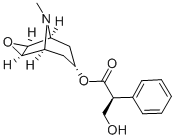CHEMICAL AND PHYSICAL PROPERTIES
| Color/Form | Viscous liquid |
|---|---|
| Melting Point | 59 °C |
| Solubility | Crystals from acetone; very sol in water and alcohol; pH of 0.05 molar soln: 5.85 /Scopolamine hydrochloride/ |
| LogP | log Kow = 0.98 |
| Stability/Shelf Life | The commercially available transdermal system of scopolamine should be stored at controlled room temperature between 20 and 25 °C. Scopolamine hydrobromide should be stored in tight, light-resistant containers. Scopolamine hydrobromide injections should be stored in light-resistant, single-dose or multiple-dose containers, preferably of USP Type I glass, at 15 to 30 °C; freezing of the injections should be avoided. Commercially available scopolamine hydrobromide soluble tablets should be stored at controlled room temperature (15 to 30 °C). |
| Optical Rotation | Orthorhombic sphenoidal crystals from water, slightly efflorescent in dry air. MP 195 °C (after drying at 105 °For 3 hrs). Specific optical rotation: -24 to -26 deg at 25 °C/D ( c = 5, calculated on anhydrous basis). UV max (emethanol): 246, 252, 258, 264 nm (A (1%, 1 cm): 3.5, 4.0, 4,5, 3.0). pH of 0.5M solution 5.85. One gram dissolves in 1.5 ML water, 20 mL alcohol. Slightly soluble in chloroform. Practically insoluble in ether. /Hydrobromide trihydrate/ |
| Ionization Efficiency | Positive |
| Dissociation Constants | pKa = 7.75 |
| Kovats Retention Index | 2130 |
| Other Experimental Properties | Crystals. Freely soluble in water, dilute alcohol; slightly soluble in absolute alcohol /Methyl nitrate/ |
COMPUTED DESCRIPTORS
| Molecular Weight | 303.35 g/mol |
|---|---|
| XLogP3 | 0.9 |
| Hydrogen Bond Donor Count | 1 |
| Hydrogen Bond Acceptor Count | 5 |
| Rotatable Bond Count | 5 |
| Exact Mass | 303.14705815 g/mol |
| Monoisotopic Mass | 303.14705815 g/mol |
| Topological Polar Surface Area | 62.3 Ų |
| Heavy Atom Count | 22 |
| Formal Charge | 0 |
| Complexity | 418 |
| Isotope Atom Count | 0 |
| Defined Atom Stereocenter Count | 4 |
| Undefined Atom Stereocenter Count | 1 |
| Defined Bond Stereocenter Count | 0 |
| Undefined Bond Stereocenter Count | 0 |
| Covalently-Bonded Unit Count | 1 |
| Compound Is Canonicalized | Yes |
PRODUCT INTRODUCTION
description
Scopolamine is a tropane alkaloid derived from plants of the nightshade family (Solanaceae), specifically Hyoscyamus niger and Atropa belladonna, with anticholinergic, antiemetic and antivertigo properties. Structurally similar to acetylcholine, scopolamine antagonizes acetylcholine activity mediated by muscarinic receptors located on structures innervated by postganglionic cholinergic nerves as well as on smooth muscles that respond to acetylcholine but lack cholinergic innervation. The agent is used to cause mydriasis, cycloplegia, to control the secretion of saliva and gastric acid, to slow gut motility, and prevent vomiting.

